More than 46 million homes in the U.S. are graced by the presence of a cat. The soothing purrs, playful antics, and affectionate cuddles make them cherished members of countless families. However, for allergy sufferers, the dream of cat companionship can often be overshadowed by sneezes, itchy eyes, and sniffles. If you adore cats but dread the allergic reactions, you might have heard about “hypoallergenic” breeds. But what exactly does hypoallergenic mean when it comes to cats, and are these breeds truly allergy-proof?
This article dives deep into the world of hypoallergenic cats, exploring what makes certain breeds less likely to trigger allergies and which feline friends might be the purrfect fit for your allergy concerns.
Decoding Hypoallergenic Cats: It’s About Allergens, Not Absence
Before we jump into specific breeds, it’s crucial to understand one key fact: no cat breed is truly 100% hypoallergenic. The term “hypoallergenic” in cats is a bit of a misnomer. It doesn’t mean these cats produce no allergens. Instead, it signifies that they produce fewer allergens compared to other breeds.
The primary culprit behind cat allergies is a protein called Fel d 1. This protein is primarily found in cat saliva, skin glands, and dander (dead skin flakes). When cats groom themselves, they deposit saliva onto their fur. As the saliva dries, the Fel d 1 protein becomes airborne along with dander and loose fur. This is what allergy sufferers react to when they inhale these particles or come into contact with them.
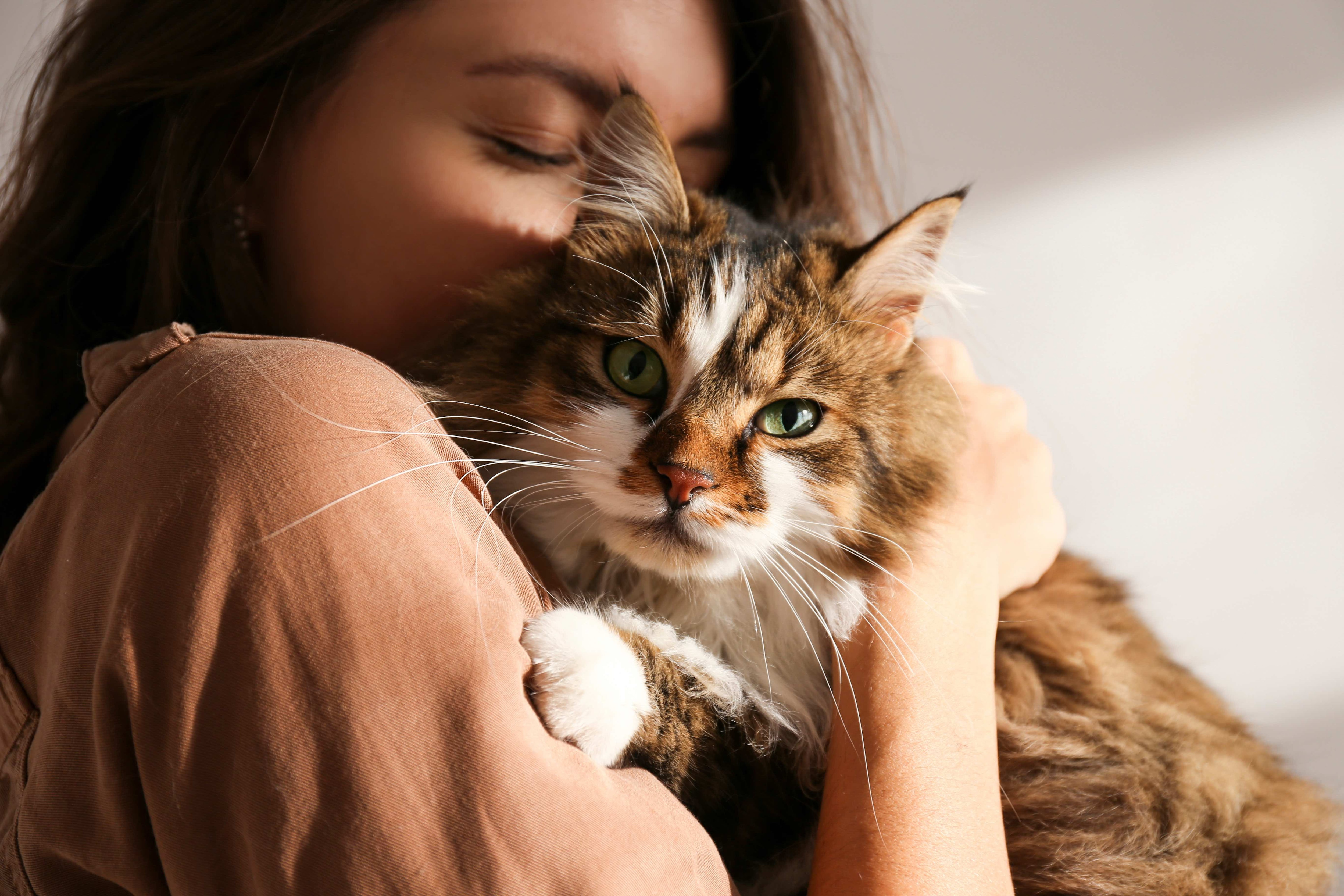 woman snuggling a longhair brown and white siberian cat
woman snuggling a longhair brown and white siberian cat
A woman lovingly embraces a Siberian cat, a breed known for being hypoallergenic despite its long fur, highlighting the possibility for allergy sufferers to enjoy feline companionship.
So, “hypoallergenic” cats are breeds that naturally produce less Fel d 1 protein or shed less, thus reducing the amount of allergens released into the environment. This doesn’t eliminate allergic reactions entirely, but it can significantly lessen them for many individuals.
12 Cat Breeds Often Considered Hypoallergenic
While individual reactions can vary, certain cat breeds are consistently reported to be better tolerated by allergy sufferers. It’s essential to remember that spending time with a cat breed before bringing it home is always the best way to gauge your personal reaction. Here are 12 breeds often cited as “hypoallergenic”:
1. Siberian
Siberians are a remarkable example of a hypoallergenic cat breed that defies expectations. Despite their luxurious, long, and thick triple coat, they are known for producing less Fel d 1 protein in their saliva than many other breeds. This lower allergen production, coupled with their dense coat that traps dander, can make them a wonderful choice for allergy-prone individuals.
Beyond their hypoallergenic qualities, Siberians are celebrated for their gentle and affectionate nature. They are known to be friendly, playful, and intelligent, making them excellent family pets. However, their magnificent coat does require regular grooming to prevent matting and tangles. If you’re prepared for brushing sessions and seeking a loving, less-allergenic long-haired companion, the Siberian could be your perfect match.
2. Siamese
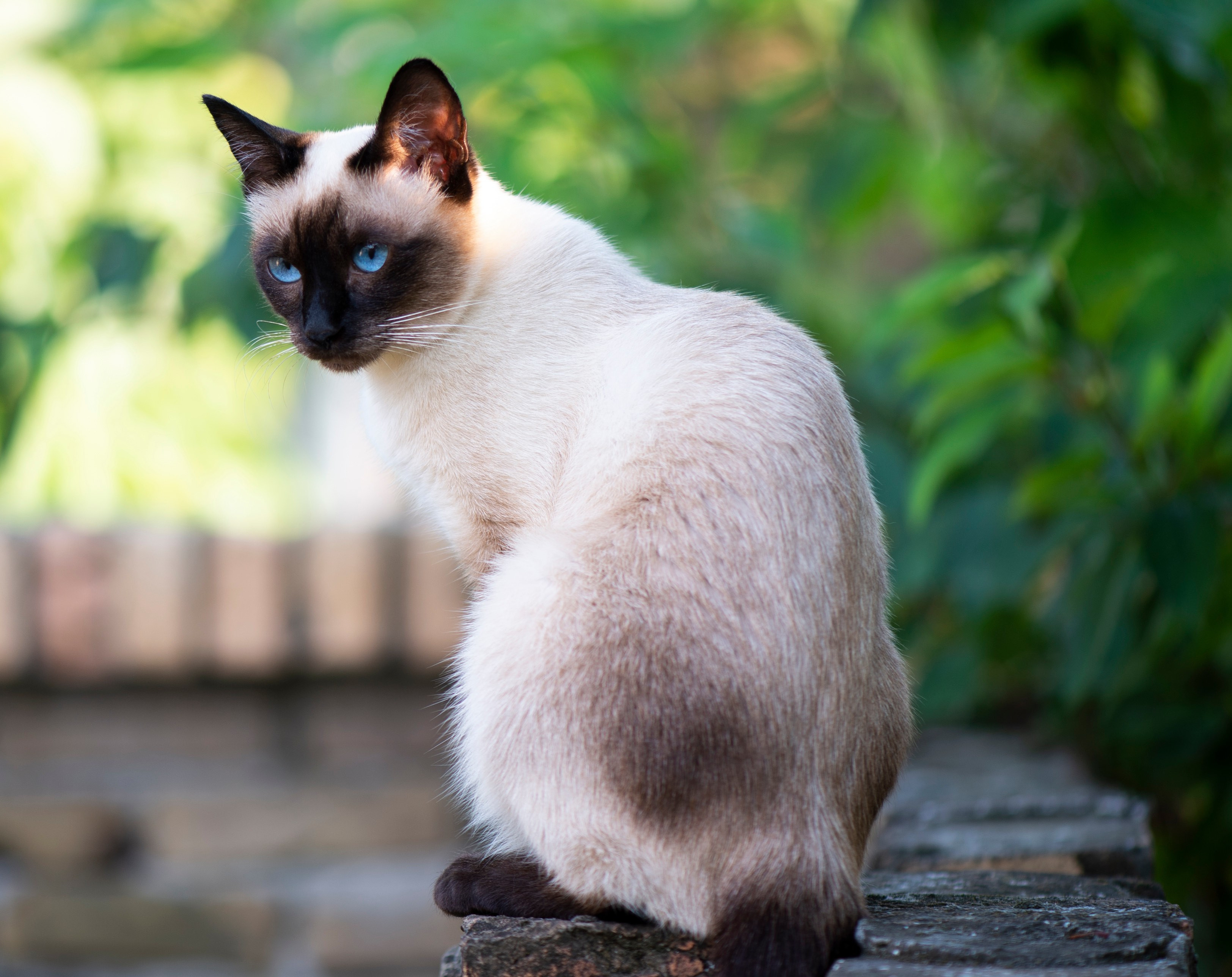 siamese cat sitting outside
siamese cat sitting outside
A sleek Siamese cat with striking blue eyes sits outdoors, representing a hypoallergenic breed known for its short coat and reduced shedding, making it potentially suitable for allergy sufferers.
The elegant Siamese cat, with its striking blue almond-shaped eyes and short, sleek coat, is another breed often recommended for allergy sufferers. While no cat is entirely non-shedding, Siamese cats have a minimal undercoat and shed less than many long-haired breeds. This reduced shedding translates to fewer allergens being dispersed around your home.
Siamese cats are renowned for their vocal and social personalities. They are intelligent, curious, and form strong bonds with their human families, often following them around the house and engaging in conversations with their distinctive meows. However, their need for attention means they thrive in homes where they are not left alone for extended periods. If you’re looking for an interactive, communicative, and less-allergenic feline companion, the Siamese might be an ideal choice.
3. Bengal
Bengal cats are a captivating and unique breed that brings a touch of the wild into your home. Their stunning, spotted or marbled coats, reminiscent of their Asian Leopard Cat ancestry, are not only visually striking but also contribute to their hypoallergenic nature. Bengal cats have a fine, pelt-like coat that sheds very little, reducing the dispersal of allergens.
Beyond their exotic appearance, Bengals are known for their high energy levels, intelligence, and playful personalities. They are curious, active cats who enjoy climbing, exploring, and interactive play. However, their energetic nature and wild ancestry mean they require experienced owners who can provide ample stimulation and may be subject to regulations in some areas. If you’re prepared for an active and engaging companion and appreciate a less-allergenic breed with a wild flair, the Bengal could be a thrilling addition to your life.
4. Russian Blue
 russian blue cat headbutting a man
russian blue cat headbutting a man
A Russian Blue cat affectionately nudges its head against a man, showcasing the breed’s gentle temperament and hypoallergenic qualities, making it a popular choice for allergy-conscious cat lovers.
Russian Blue cats are admired for their plush, silvery-blue coats, striking green eyes, and gentle personalities. Their dense, short coat is not only beautiful but also contributes to their hypoallergenic reputation. While they do shed, they produce less Fel d 1 protein and their dense coat helps trap dander, minimizing allergen release.
Russian Blues are known for their calm and quiet demeanor, making them wonderful companions for those seeking a more serene feline friend. They are affectionate with their families but can be initially reserved with strangers, often developing deep bonds with their chosen humans. Their low-shedding coat requires minimal grooming, adding to their appeal. If you desire a beautiful, gentle, and less-allergenic cat with a calm presence, the Russian Blue is a breed worth considering.
5. Sphynx
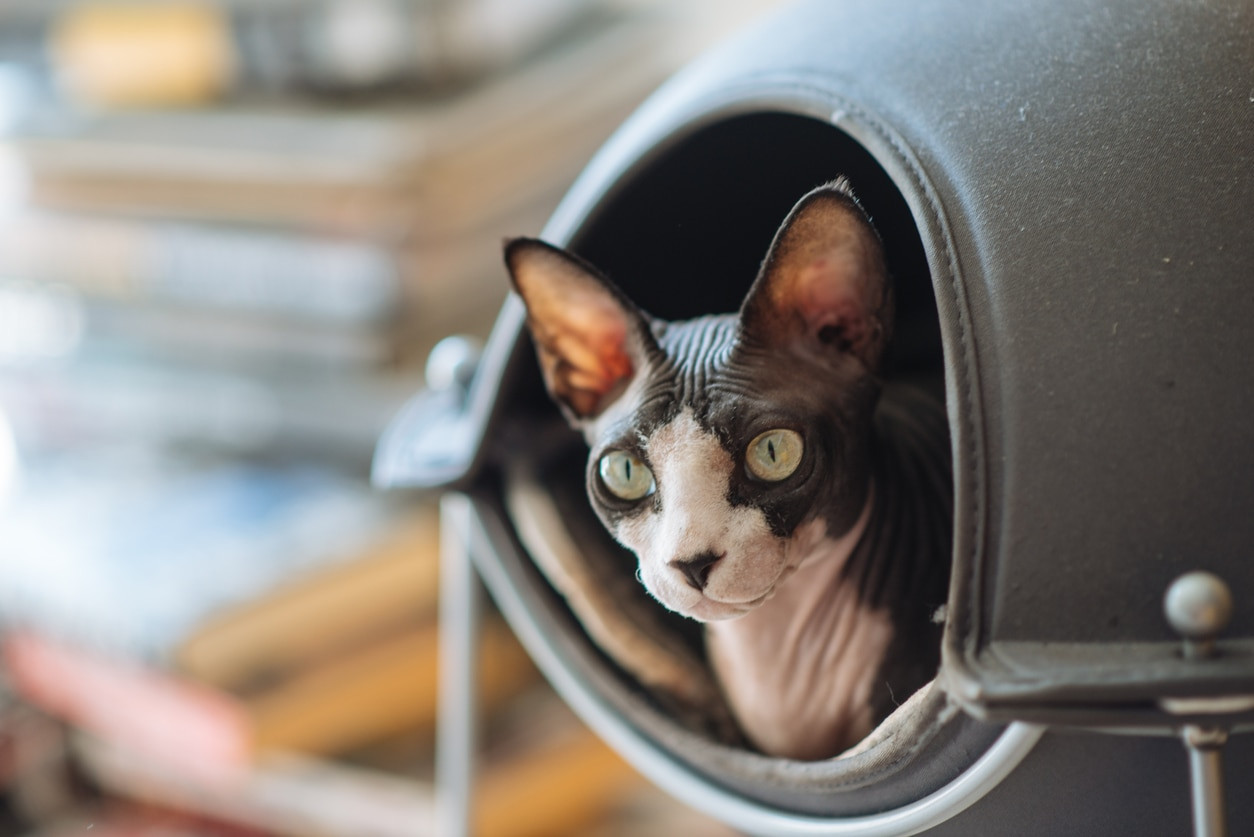 black and pink sphynx cat looking out of a covered cat bed
black and pink sphynx cat looking out of a covered cat bed
A Sphynx cat with black and pink skin peers out from a cozy bed, illustrating the unique appearance of this hairless, hypoallergenic breed that requires special skincare despite lacking fur.
The Sphynx cat stands out with its undeniably unique appearance – virtually hairless, with wrinkled skin and large ears. Their lack of fur is the primary reason they are considered hypoallergenic. Without hair to trap dander and saliva, the amount of airborne allergens is significantly reduced.
However, “hairless” doesn’t mean maintenance-free. Sphynx cats require regular bathing to remove oils that accumulate on their skin. They are also sensitive to temperature changes and need protection from both cold and sun. Personality-wise, Sphynx cats are known for being incredibly affectionate, social, and even dog-like in their devotion to their families. If you’re prepared for their specific care needs and are drawn to a truly unique, hypoallergenic, and attention-loving cat, the Sphynx might be an extraordinary companion.
6. Devon Rex
Devon Rex cats are characterized by their large ears, pixie-like faces, and soft, wavy, short coats. Their unique coat texture is due to a genetic mutation that results in less hair and finer hair compared to many other breeds. This minimal coat, combined with less shedding, contributes to their hypoallergenic qualities.
Devon Rex cats are known for their playful, mischievous, and outgoing personalities. They are often described as “monkey-like” or “elfin” due to their energetic antics and love for climbing and exploring. They are intelligent and enjoy interactive play and puzzle toys. While affectionate, they can be demanding of attention and may not thrive if left alone for long periods. If you are seeking a playful, entertaining, and less-allergenic cat breed that will keep you on your toes, the Devon Rex could be a delightful choice.
7. Cornish Rex
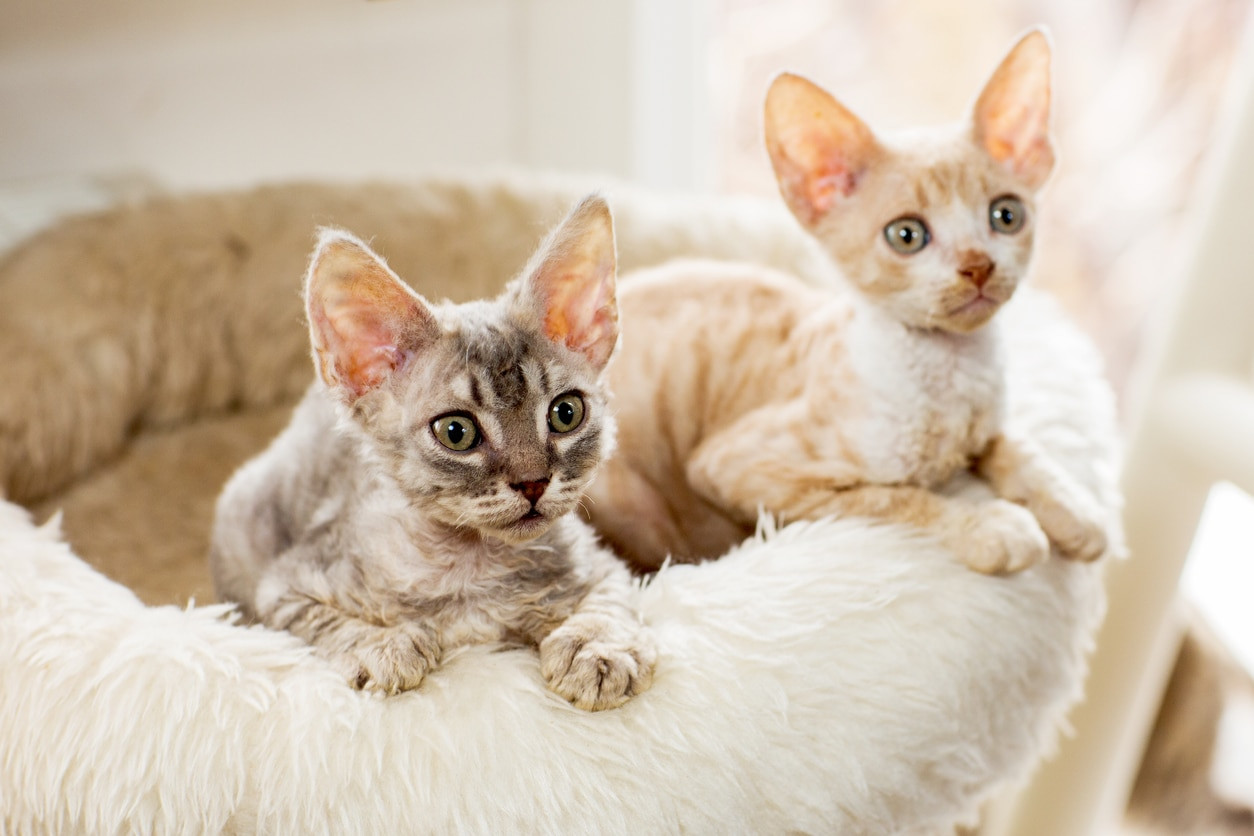 two cornish rex kittens in a cat bed
two cornish rex kittens in a cat bed
Two adorable Cornish Rex kittens snuggle in a cat bed, highlighting the breed’s soft, curly coat and affectionate nature, making them a charming and potentially hypoallergenic pet choice.
Similar to the Devon Rex, Cornish Rex cats possess a distinctive curly coat, but with even shorter and finer hair. This “washboard” or “rippled” coat is incredibly soft to the touch and sheds minimally, making them another excellent hypoallergenic breed option.
Cornish Rex cats are known for their affectionate, people-oriented, and playful personalities. They are often described as “cat-dogs” due to their eagerness to interact with their families and their love of fetching and playing games. They are intelligent and can be easily trained. Like Devon Rexes, they crave attention and may not be suitable for owners who are frequently away from home. If you are looking for a cuddly, playful, and low-shedding cat that will be your constant companion, the Cornish Rex is a breed to consider.
8. Javanese
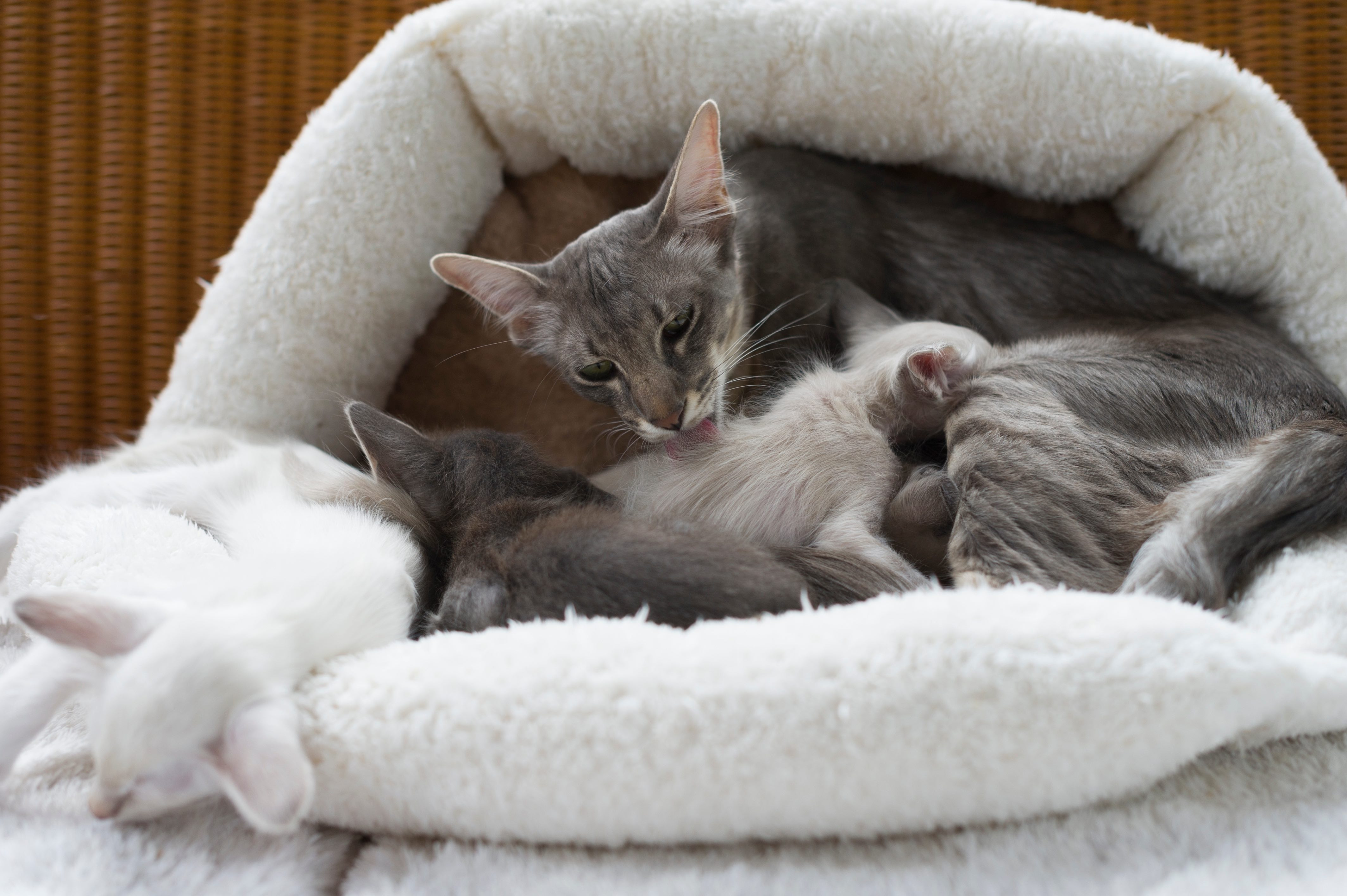 gray javanese cat mom grooming her kittens
gray javanese cat mom grooming her kittens
A Javanese mother cat with a sleek gray coat grooms her kittens, showcasing the breed’s elegant appearance and hypoallergenic qualities despite having a longer coat than some other hypoallergenic breeds.
Javanese cats are a striking and intelligent breed, often considered a variant of the Balinese and Siamese lineage. They possess a silky, medium-length single coat, meaning they lack the dense undercoat of many long-haired breeds. Despite their longer hair, they shed less than cats with double coats and produce less Fel d 1, contributing to their hypoallergenic status.
Javanese cats are known for their intelligence, curiosity, and vocal nature. They are highly social and form strong attachments to their families, often following their owners around and engaging in conversations with their distinctive meows. They are playful and enjoy interactive toys and puzzle feeders. If you desire a beautiful, intelligent, and vocal companion that is also less allergenic, the Javanese might be a perfect fit.
9. Balinese
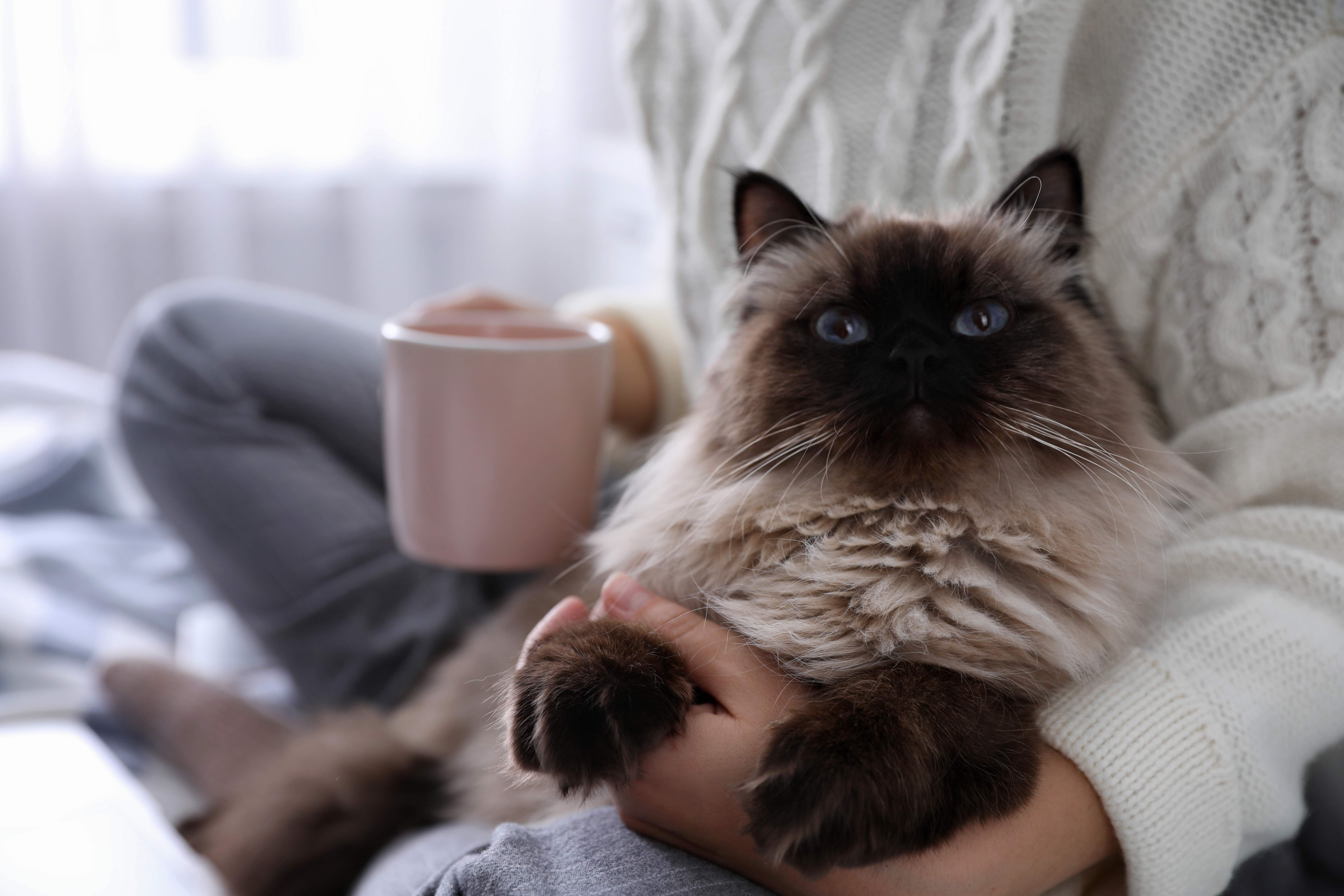 longhaired balinese cat snuggling with a woman
longhaired balinese cat snuggling with a woman
A Balinese cat with long, flowing fur snuggles affectionately with a woman, demonstrating that even long-haired breeds can be hypoallergenic, offering companionship to allergy sufferers.
The Balinese cat, often referred to as the “long-haired Siamese,” shares the same elegant lines and striking blue eyes as its Siamese relative but boasts a luxurious, flowing coat. Despite their long hair, Balinese cats are considered hypoallergenic because they produce less Fel d 1 protein. Their single coat also sheds less than double-coated breeds, further reducing allergen dispersal.
Balinese cats are renowned for their intelligence, affectionate nature, and vocal personalities, just like Siamese cats. They are highly social, enjoy human companionship, and can be trained to perform tricks. They are playful and curious, thriving in homes where they receive plenty of attention and interaction. If you are drawn to the beauty of a long-haired cat but need a less-allergenic option, the Balinese offers the best of both worlds.
10. Oriental Shorthair
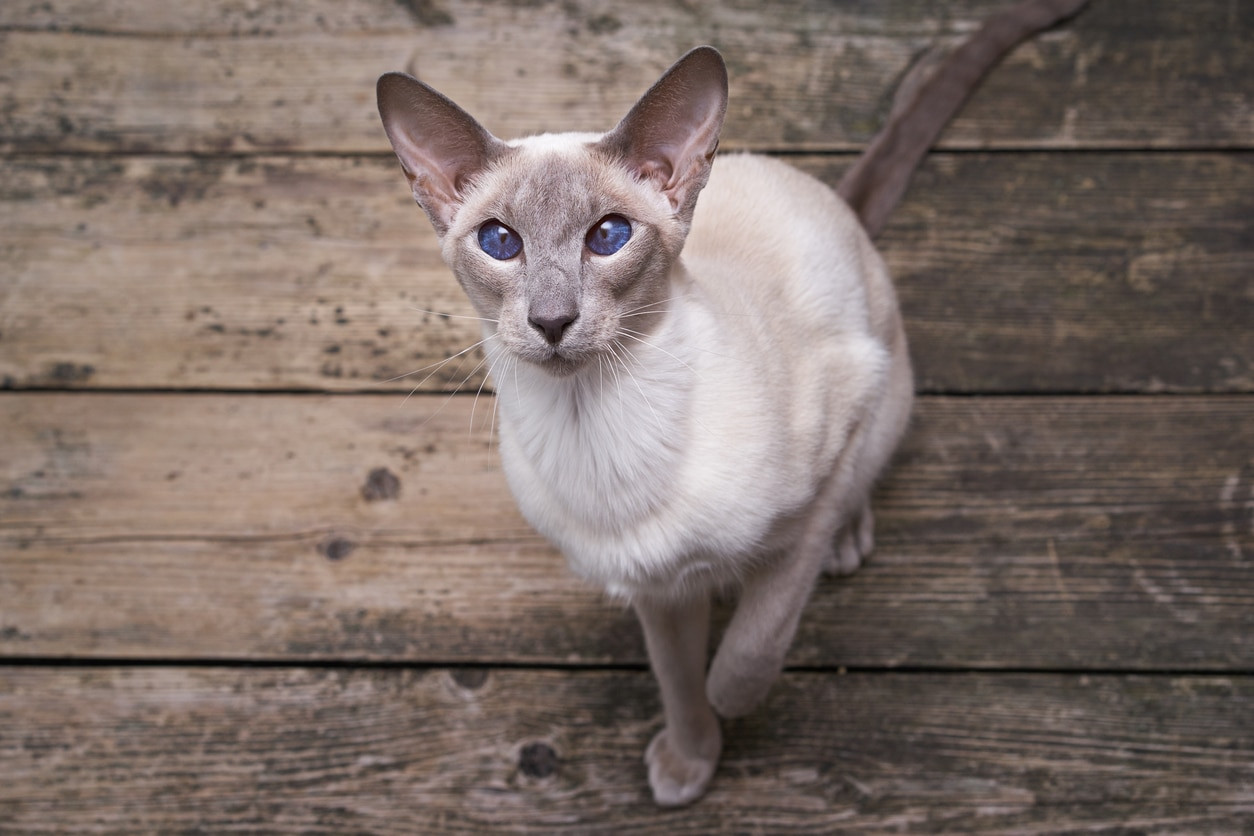 gray and white oriental shorthair cat looking up at the camera
gray and white oriental shorthair cat looking up at the camera
An Oriental Shorthair cat with a striking gray and white patterned coat gazes at the camera, highlighting the breed’s sleek appearance and hypoallergenic nature due to its short, minimal-shedding coat.
Oriental Shorthair cats are known for their sleek, elegant appearance, large ears, and expressive almond-shaped eyes. They are essentially Siamese cats in a vast array of colors and patterns beyond the traditional pointed coloration. Their short, fine coat sheds minimally, contributing to their hypoallergenic reputation.
Oriental Shorthairs are intelligent, curious, and highly energetic cats. They are known for their playful antics, love of climbing and exploring, and their strong attachment to their families. They are vocal and communicative, often “talking” to their owners with a distinctive meow that some describe as goose-like. If you are seeking an active, intelligent, and less-allergenic short-haired cat with a unique personality, the Oriental Shorthair could be a captivating companion.
11. Burmese
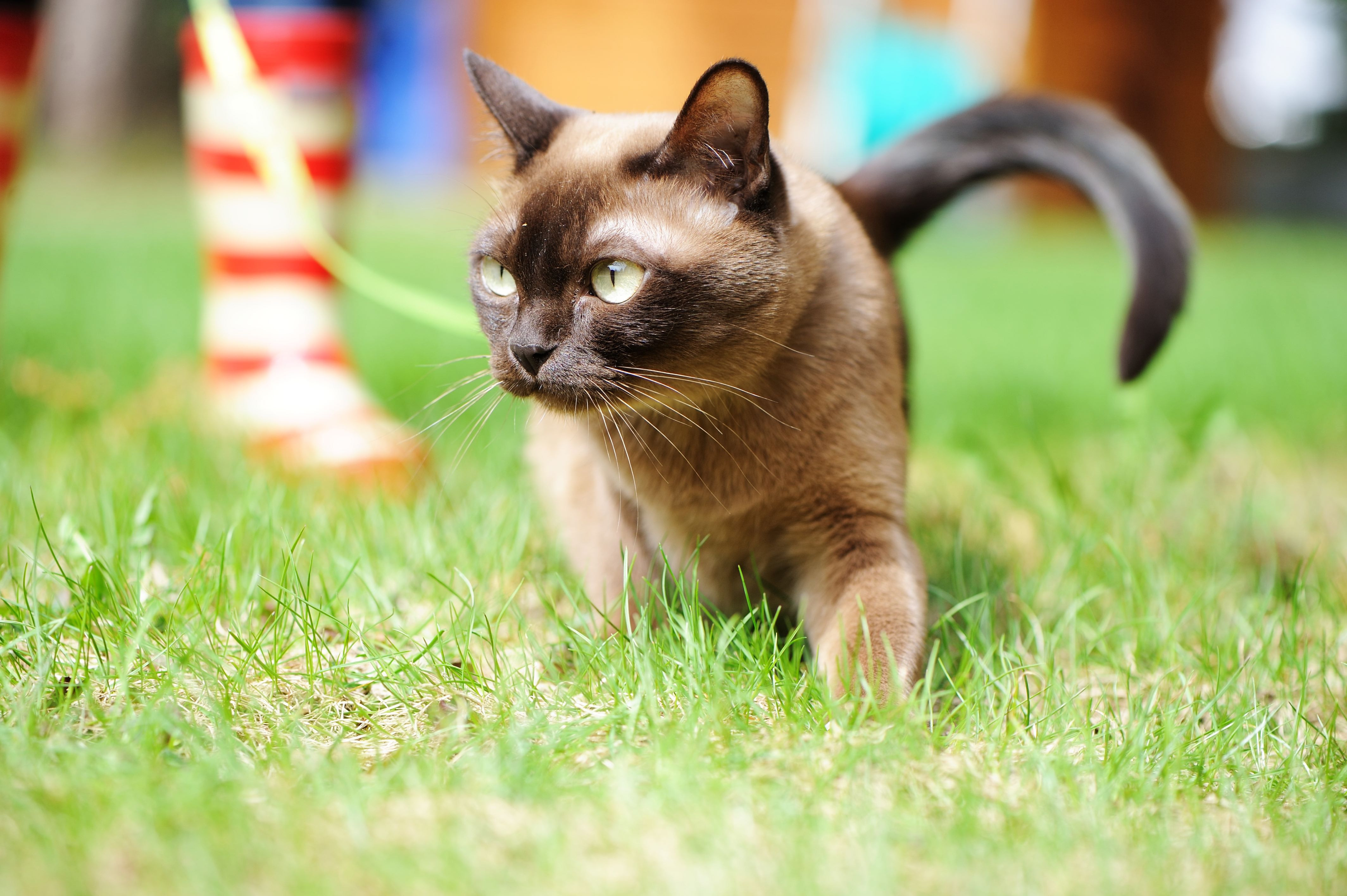 burmese cat walking on a leash and harness outside
burmese cat walking on a leash and harness outside
A Burmese cat confidently walks on a leash outdoors, showcasing the breed’s adventurous spirit and hypoallergenic coat, making it suitable for owners seeking an active and allergy-friendly pet.
Burmese cats are compact, muscular, and known for their silky, satin-like short coats. This fine coat sheds very little and requires minimal grooming, making them a low-maintenance and potentially hypoallergenic breed.
Burmese cats are renowned for their affectionate, people-oriented, and playful personalities. They are often described as “velcro cats” due to their desire to be close to their owners. They are intelligent, curious, and enjoy interactive play and puzzle toys. While active, they are generally less demanding than some other highly energetic breeds. If you are looking for a cuddly, devoted, and low-shedding cat that is also relatively easy to care for, the Burmese might be an excellent choice.
12. Tonkinese
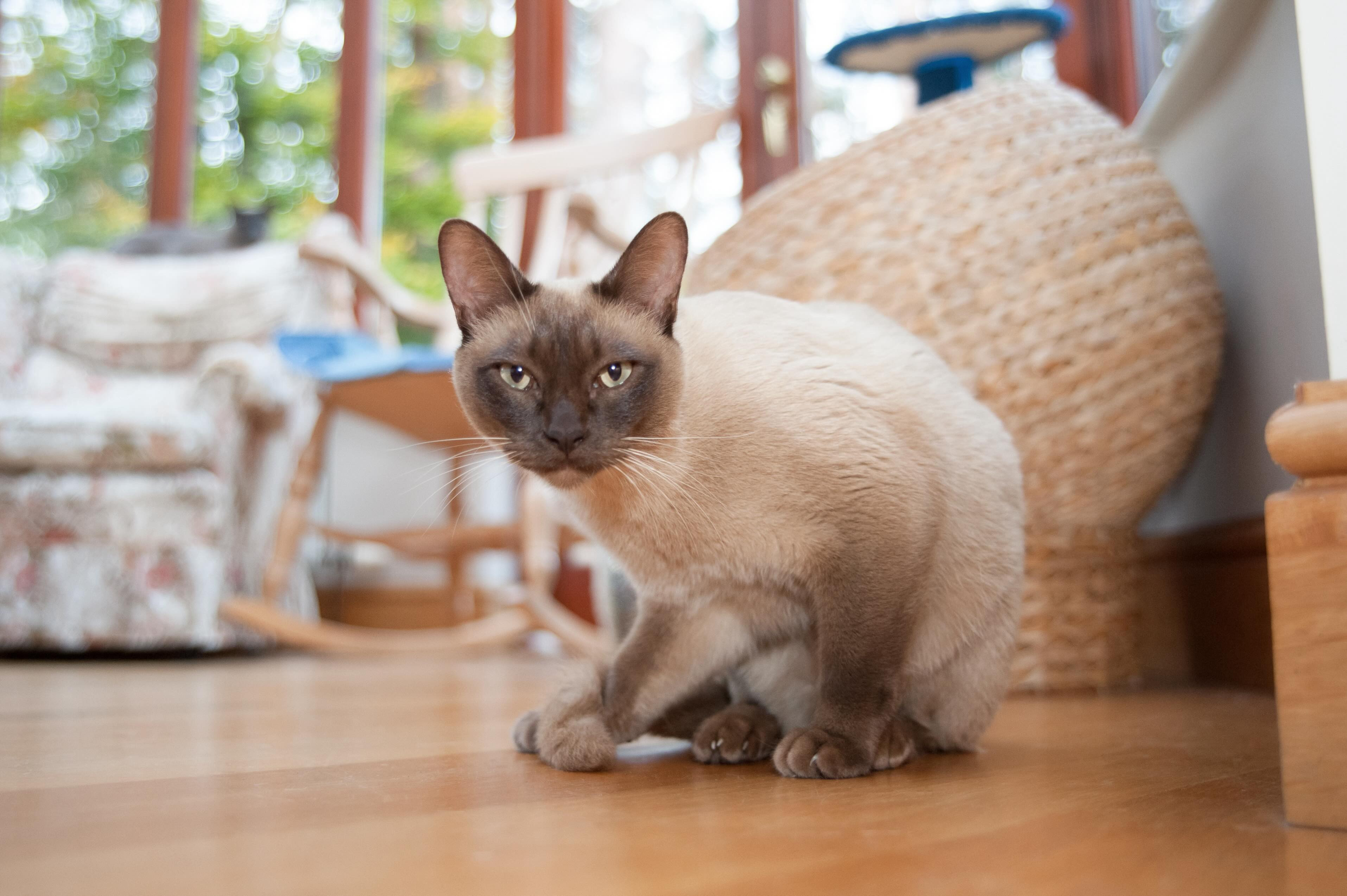 champagne tonkinese cat sitting on the floor and looking straight at the camera
champagne tonkinese cat sitting on the floor and looking straight at the camera
A Tonkinese cat with a champagne-colored coat sits and looks directly at the camera, illustrating the breed’s elegant appearance and hypoallergenic traits, making it a popular choice for allergy-conscious cat enthusiasts.
Tonkinese cats are a delightful blend of Siamese and Burmese traits, both in appearance and personality. They possess a short, fine coat that is incredibly soft and sheds minimally, inheriting the hypoallergenic qualities of their parent breeds.
Tonkinese cats are known for their affectionate, playful, and intelligent personalities. They are social and enjoy being around people, often forming strong bonds with their families. They are vocal but typically less so than Siamese cats. They are active and enjoy interactive play but are also content to cuddle up with their owners. If you are seeking a balanced, affectionate, and less-allergenic cat breed that combines the best of Siamese and Burmese traits, the Tonkinese could be a perfect match.
Tips for Living Comfortably with a Hypoallergenic Cat
Choosing a hypoallergenic breed is a great first step, but managing cat allergies involves more than just breed selection. Here are some additional tips to minimize allergy symptoms even with a hypoallergenic cat:
Do Thorough Research
Before you fall in love with a particular breed, delve deeper into research. Read breed-specific articles, connect with breeders or rescue organizations, and if possible, spend time with cats of that breed to assess your personal allergic reaction.
Consult an Allergy Specialist
If you have significant allergies, consulting an allergist is highly recommended. They can perform allergy testing to pinpoint your specific triggers and recommend appropriate strategies, including medication or allergy shots, to manage your symptoms effectively.
Create an Allergy-Conscious Home Environment
Maintaining a clean home is crucial for managing cat allergies. Regular vacuuming with a HEPA filter vacuum cleaner, frequent dusting, and washing bedding and curtains can significantly reduce allergen levels. Consider using air purifiers with HEPA filters to further cleanse the air.
Explore Allergen-Reducing Cat Food
Innovative cat food formulas, such as Purina® Pro Plan® LIVECLEAR, are designed to reduce the active Fel d 1 allergen in cat saliva. Discuss with your veterinarian whether such a diet could be beneficial for your cat and your allergies.
Regular Grooming is Still Key
Even hypoallergenic cats require regular grooming. Bathing your cat regularly (as tolerated by the cat and recommended by your vet) and brushing them frequently can help remove loose fur and dander, further minimizing allergen dispersal.
Spend Time Before Committing
The most crucial step is to spend time with the specific cat or breed you are considering before bringing them home permanently. Allergic reactions can vary from person to person and even between individual cats within a breed. Arrange visits with the cat to observe your reaction before making a final decision.
FAQs About Hypoallergenic Cats
Are there truly non-shedding cats?
No cat is truly non-shedding. Even hairless breeds like the Sphynx still produce dander and skin oils. While they don’t shed fur, they still require skincare to manage oil buildup on their skin.
Can cats be 100% hypoallergenic?
No, the concept of a 100% hypoallergenic cat is a myth. All cats produce Fel d 1 protein, the primary cat allergen. Hypoallergenic breeds simply produce less of it or release fewer allergens into the environment due to coat type and shedding patterns.
In Conclusion:
While the dream of a completely allergy-free cat might be unattainable, the reality of hypoallergenic breeds offers a ray of hope for cat lovers with allergies. By understanding what “hypoallergenic” truly means, exploring suitable breeds, and implementing allergy management strategies, you can increase your chances of finding a feline companion to share your life with, sneezes and sniffles minimized. Remember to always prioritize spending time with a cat before adoption to ensure a comfortable and joyful companionship for both you and your new furry friend.
